本篇将重点讲解vue中的多种组件通信方式,包括【父传子】【子传父】【兄弟组件通信】【依赖注入】等等,并提供具体案例来让小伙伴们加深理解、彻底掌握!喜欢的小伙伴们点赞收藏,持续关注哦~💕
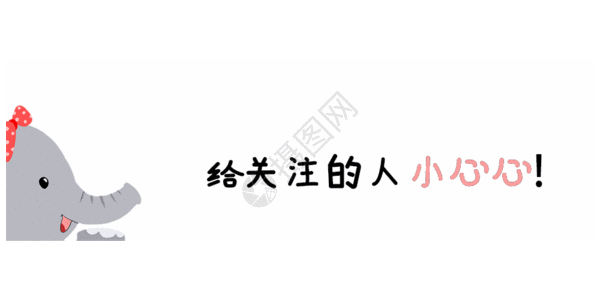
💟 上一篇文章 史上最详细的Vue入门教程(六) --- 工程化开发和脚手架、组件注册
📝 系列专栏 vue从基础到起飞

目录
一、组件通信
1.什么是组件通信?
组件通信,就是指组件与组件之间的数据传递
-
组件的数据是独立的,无法直接访问其他组件的数据。
-
想使用其他组件的数据,就需要组件通信
2.组件关系分类
-
父子关系
-
非父子关系
-

3.通信解决方案

4.父子通信流程
-
父组件通过 props 将数据传递给子组件
-
子组件利用 $emit 通知父组件修改更新
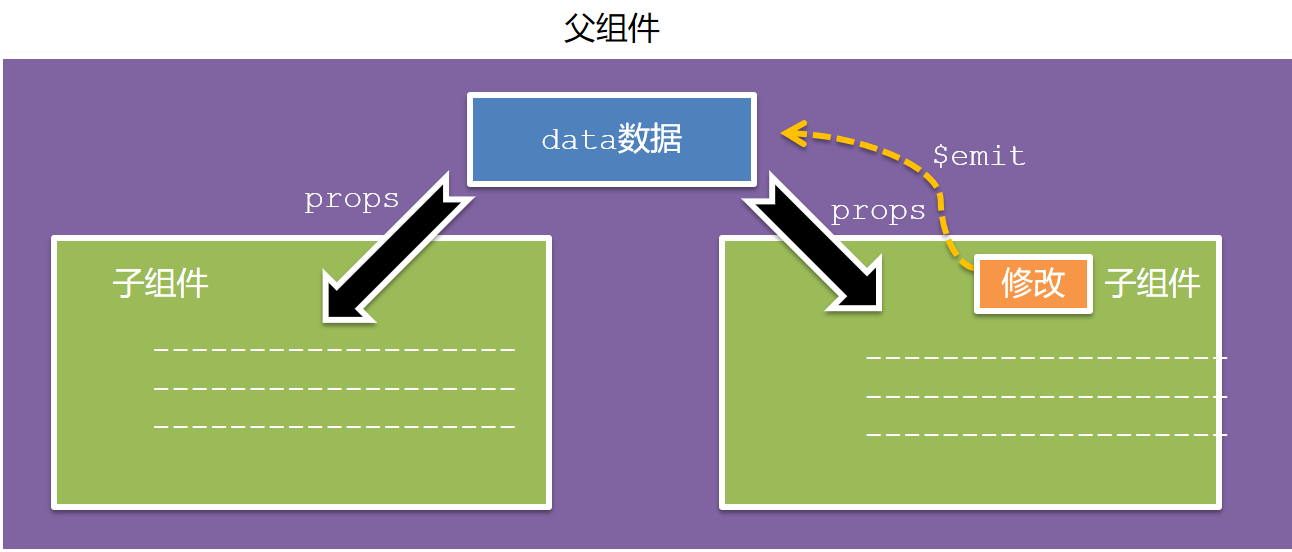
5.父向子通信代码示例
父组件通过props将数据传递给子组件
父组件App.vue
<template>
<div class="app" style="border: 3px solid #000; margin: 10px">
我是APP组件
<!-- 1.给组件标签,添加属性方式 赋值 -->
<Son :title="myTitle"></Son>
</div>
</template>
<script>
import Son from './components/Son.vue'
export default {
name: 'App',
data() {
return {
myTitle: '前端菜鸟的自我修养',
}
},
components: {
Son,
},
}
</script>
<style>
</style>子组件Son.vue
<template>
<div class="son" style="border:3px solid #000;margin:10px">
<!-- 3.直接使用props的值 -->
我是Son组件 {{title}}
</div>
</template>
<script>
export default {
name: 'Son-Child',
// 2.通过props来接受
props:['title']
}
</script>
<style>
</style>父向子传值步骤
-
给子组件以添加属性的方式传值
-
子组件内部通过props接收
-
模板中直接使用 props接收的值
6.子向父通信代码示例
子组件利用 $emit 通知父组件,进行修改更新
子组件Son.vue
<template>
<div class="son" style="border: 3px solid #000; margin: 10px">
我是Son组件 {{ title }}
<button @click="changeFn">修改title</button>
</div>
</template>
<script>
export default {
name: 'Son-Child',
props: ['title'],
methods: {
changeFn() {
// 通过this.$emit() 向父组件发送通知
this.$emit('changTitle','前端菜鸟的自我修养')
},
},
}
</script>
<style>
</style>父组件App.vue
<template>
<div class="app" style="border: 3px solid #000; margin: 10px">
我是APP组件
<!-- 2.父组件对子组件的消息进行监听 -->
<Son :title="myTitle" @changTitle="handleChange"></Son>
</div>
</template>
<script>
import Son from './components/Son.vue'
export default {
name: 'App',
data() {
return {
myTitle: '学前端',
}
},
components: {
Son,
},
methods: {
// 3.提供处理函数,提供逻辑
handleChange(newTitle) {
this.myTitle = newTitle
},
},
}
</script>
<style>
</style>子向父传值步骤
-
$emit触发事件,给父组件发送消息通知
-
父组件监听$emit触发的事件
-
提供处理函数,在函数的性参中获取传过来的参数
二、详解props
1.Props 定义
组件上 注册的一些 自定义属性
2.Props 作用
向子组件传递数据
3.特点
-
可以 传递 任意数量 的prop
-
可以 传递 任意类型 的prop
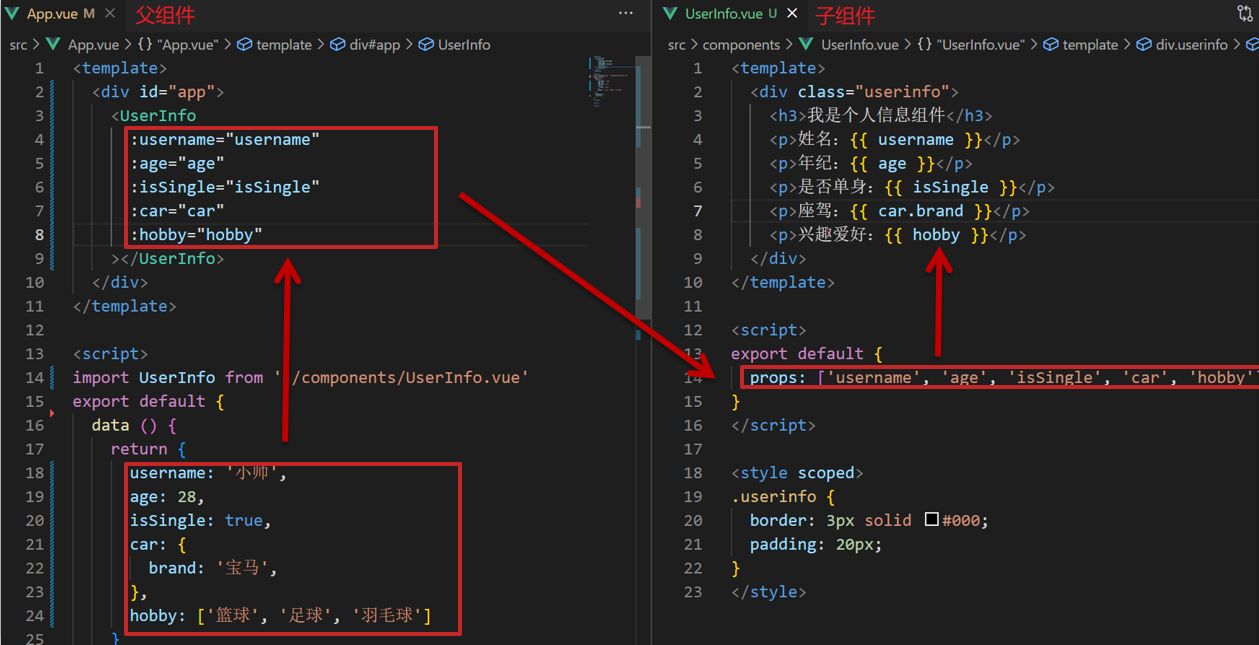
4.代码演示
父组件App.vue
<template>
<div class="app">
<UserInfo
:username="username"
:age="age"
:isSingle="isSingle"
:car="car"
:hobby="hobby"
></UserInfo>
</div>
</template>
<script>
import UserInfo from './components/UserInfo.vue'
export default {
data() {
return {
username: '小帅',
age: 28,
isSingle: true,
car: {
brand: '宝马',
},
hobby: ['篮球', '足球', '羽毛球'],
}
},
components: {
UserInfo,
},
}
</script>
<style>
</style>子组件UserInfo.vue
<template>
<div class="userinfo">
<h3>我是个人信息组件</h3>
<div>姓名:{{username}}</div>
<div>年龄:{{age}}</div>
<div>是否单身:{{isSingle}}</div>
<div>座驾:{{car.brand}}</div>
<div>兴趣爱好:{{hobby.join('、')}}</div>
</div>
</template>
<script>
export default {
props:['username','age','isSingle','car','hobby']
}
</script>
<style>
.userinfo {
width: 300px;
border: 3px solid #000;
padding: 20px;
}
.userinfo > div {
margin: 20px 10px;
}
</style>三、props校验
1.思考
组件的props可以乱传吗?
2.作用
为组件的 prop 指定验证要求,不符合要求,控制台就会有错误提示 → 帮助开发者,快速发现错误
3.语法
-
类型校验
-
非空校验
-
默认值
-
自定义校验

4.代码演示
App.vue
<template>
<div class="app">
<BaseProgress :w="width"></BaseProgress>
</div>
</template>
<script>
import BaseProgress from './components/BaseProgress.vue'
export default {
data() {
return {
width: 50,
}
},
components: {
BaseProgress,
},
}
</script>
<style>
</style>子组件 BaseProgress.vue(写了一个简单的进度条组件)
<template>
<div class="base-progress">
<div class="inner" :style="{ width: w + '%' }">
<span>{{ w }}%</span>
</div>
</div>
</template>
<script>
export default {
props: {
w: Number,
},
}
</script>
<style scoped>
.base-progress {
height: 26px;
width: 400px;
border-radius: 15px;
background-color: #272425;
border: 3px solid #272425;
box-sizing: border-box;
margin-bottom: 30px;
}
.inner {
position: relative;
background: #379bff;
border-radius: 15px;
height: 25px;
box-sizing: border-box;
left: -3px;
top: -2px;
}
.inner span {
position: absolute;
right: 0;
top: 26px;
}
</style>实现了进度条显示50%的进度,效果图如下:

四、props校验完整写法
1.语法
props: {
校验的属性名: {
type: 类型, // Number String Boolean ......
required: true, // 是否必填
default: 默认值, // 默认值
validator (value) {
// 自定义校验逻辑
return 是否通过校验
}
}
},
2.代码实例
<script>
export default {
// 完整写法(类型、默认值、非空、自定义校验)
props: {
w: {
type: Number,
required: true,
default: 0,
validator(val) {
// console.log(val)
if (val >= 100 || val <= 0) {
console.error('传入的范围必须是0-100之间')
return false
} else {
return true
}
},
},
},
}
</script>
3.注意
1.default和required一般不同时写(因为当时必填项时,肯定是有值的)
2.default后面如果是简单类型的值,可以直接写默认值。如果是复杂类型的值,则需要以函数的形式return一个默认值
五、props & data、单向数据流
1.共同点
都可以给组件提供数据
2.区别
-
data 的数据是自己的 → 随便改
-
prop 的数据是外部的 → 不能直接改,要遵循 单向数据流
3.单向数据流:
父级props 的数据更新,会向下流动,影响子组件。这个数据流动是单向的
4.代码演示
App.vue
<template>
<div class="app">
<BaseCount :count="count" @changeCount="handleChange"></BaseCount>
</div>
</template>
<script>
import BaseCount from './components/BaseCount.vue'
export default {
components:{
BaseCount
},
data(){
return {
count:100
}
},
methods:{
handleChange(newVal){
// console.log(newVal);
this.count = newVal
}
}
}
</script>
<style>
</style>BaseCount.vue
<template>
<div class="base-count">
<button @click="handleSub">-</button>
<span>{{ count }}</span>
<button @click="handleAdd">+</button>
</div>
</template>
<script>
export default {
// 1.自己的数据随便修改 (谁的数据 谁负责)
// data () {
// return {
// count: 100,
// }
// },
// 2.外部传过来的数据 不能随便修改
props: {
count: {
type: Number,
},
},
methods: {
handleSub() {
this.$emit('changeCount', this.count - 1)
},
handleAdd() {
this.$emit('changeCount', this.count + 1)
},
},
}
</script>
<style>
.base-count {
margin: 20px;
}
</style>
5.口诀
谁的数据谁负责
六、非父子通信 -- event bus 事件总线
1.作用
非父子组件之间,进行简易消息传递。(复杂场景→ Vuex)
2.步骤
-
创建一个都能访问的事件总线 (空Vue实例)
import Vue from 'vue' const Bus = new Vue() export default Bus
-
A组件(接受方),监听Bus的 $on事件
created () { Bus.$on('sendMsg', (msg) => { this.msg = msg }) } -
B组件(发送方),触发Bus的$emit事件
Bus.$emit('sendMsg', '这是一个消息')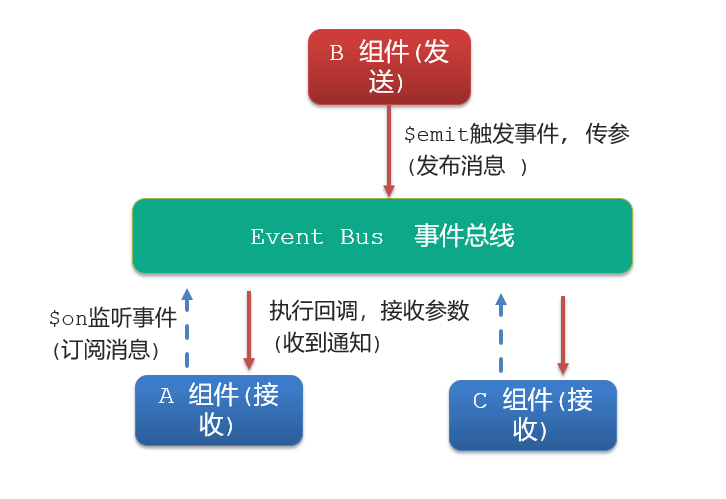
3.代码示例
新建EventBus.js,实例化一个新组件实例并向外暴露,作为兄弟组件传值的媒介
import Vue from 'vue' const Bus = new Vue() export default Bus
BaseA.vue(接收方)
<template>
<div class="base-a">
我是A组件(接受方)
<p>{{msg}}</p>
</div>
</template>
<script>
import Bus from '../utils/EventBus'
export default {
data() {
return {
msg: '',
}
},
created() {
Bus.$on('sendMsg', (msg) => {
// console.log(msg)
this.msg = msg
})
},
}
</script>
<style scoped>
.base-a {
width: 200px;
height: 200px;
border: 3px solid #000;
border-radius: 3px;
margin: 10px;
}
</style>BaseB.vue(发送方)
<template>
<div class="base-b">
<div>我是B组件(发布方)</div>
<button @click="sendMsgFn">发送消息</button>
</div>
</template>
<script>
import Bus from '../utils/EventBus'
export default {
methods: {
sendMsgFn() {
Bus.$emit('sendMsg', '今天天气不错,适合旅游')
},
},
}
</script>
<style scoped>
.base-b {
width: 200px;
height: 200px;
border: 3px solid #000;
border-radius: 3px;
margin: 10px;
}
</style>App.vue
<template>
<div class="app">
<BaseA></BaseA>
<BaseB></BaseB>
</div>
</template>
<script>
import BaseA from './components/BaseA.vue'
import BaseB from './components/BaseB.vue'
export default {
components:{
BaseA,
BaseB,
}
}
</script>
<style>
</style>七、非父子通信 -- provide&inject
1.作用
跨层级共享数据,不只是父子之间,也可以是祖父与孙子之间,曾祖父与重孙之间......
2.场景
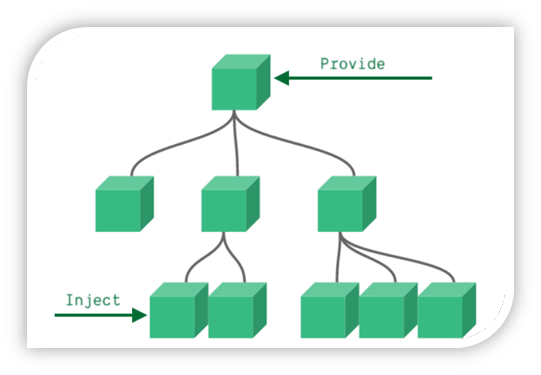
3.语法
-
父组件 provide提供数据
export default {
provide () {
return {
// 普通类型【非响应式】
color: this.color,
// 复杂类型【响应式】
userInfo: this.userInfo,
}
}
}
2.子/孙组件 inject获取数据
export default {
inject: ['color','userInfo'],
created () {
console.log(this.color, this.userInfo)
}
}
4.完整实例
爷组件
<template>
<div>
<button @click="changeMsg">祖组件触发</button>
<h1>祖组件</h1>
<parent></parent>
</div>
</template>
<script>
import parent from './parent.vue';
export default {
data(){
return{
obj:{
name:'JavaScript',
},
developer:'布兰登·艾奇',
year:1995,
update:'2021年06月',
}
},
provide(){
return {
obj: this.obj, // 方式1.传入一个可监听的对象
developerFn:() => this.developer, // 方式2.通过 computed 来计算注入的值
year: this.year, // 方式3.直接传值
app: this, // 方式4. 提供祖先组件的实例 缺点:实例上挂载很多没有必要的东西 比如:props,methods。
}
},
components: {
parent,
},
methods:{
changeMsg(){
this.obj.name = 'Vue';
this.developer = '尤雨溪';
this.year = 2014;
this.update = '2021年6月7日';
},
},
}
</script>
父组件
<template>
<div class="wrap">
<h4>子组件(只做中转)</h4>
<child></child>
</div>
</template>
<script>
import child from './child.vue';
export default {
components:{
child,
},
}
</script>
孙组件
<template>
<div>
<h5>孙组件</h5>
<span>名称:{{obj.name}}</span> |
<span>作者:{{developer}}</span> |
<span>诞生于:{{year}}</span> |
<span>最后更新于:{{this.app.update}}</span>
</div>
</template>
<script>
export default {
computed:{
developer(){
return this.developerFn()
}
},
inject:['obj','developerFn','year','app'],
}
</script>
实现效果如下图


对比一下前后差异:无论点击多少次,孙组件中的诞生于 year 字段永远都是1995 并不会发生变化,通过 方式1、方式2、方式4传值是可以响应的。
正如官网所提到的:provide 和 inject 绑定并不是可响应的。这是刻意为之的。然而,如果你传入了一个可监听的对象,那么其对象的 property 还是可响应的。
另一种情况:在孙组件中修改祖组件传递过来的值(方式1、方式4),发现对应的祖组件中的值也发生了变化:
爷组件
<template>
<div>
<h1>祖组件</h1>
<span>名称:{{obj.name}}</span> |
<span>最后更新于:{{update}}</span>
<parent></parent>
</div>
</template>
<script>
import parent from './parent.vue';
export default {
data(){
return{
obj:{
name:'JavaScript',
},
update:'2021年06月',
}
},
provide(){
return {
obj: this.obj,
app: this,
}
},
components: {
parent,
},
}
</script>
父组件不变
孙组件
<template>
<div>
<button @click="changeMsg">孙组件触发</button>
<h3>孙组件</h3>
<span>名称:{{obj.name}}</span> |
<span>最后更新于:{{this.app.update}}</span>
</div>
</template>
<script>
export default {
inject:['obj','app'],
methods: {
changeMsg(){
this.obj.name = 'React';
this.app.update = '2020年10月';
}
},
}
</script>
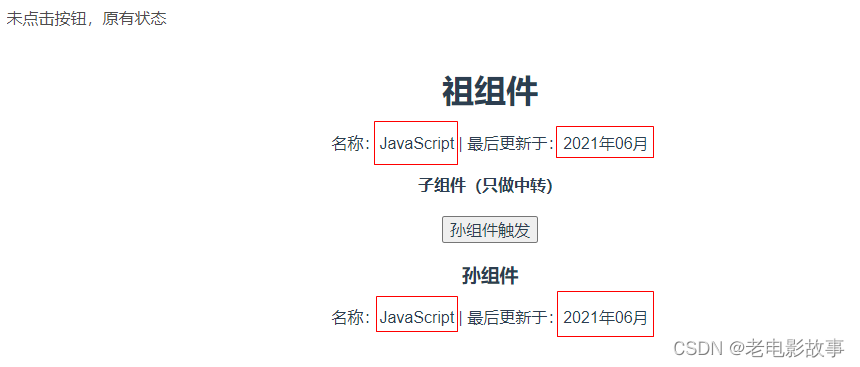

5. 总结
慎用 provide / inject
既然 provide/inject 如此好用,那么,为什么 Vue 官方还要推荐我们使用 Vuex,而不是用原生的 API 呢?
答: 前面提到过,Vuex 和 provide/inject 最大的区别:Vuex 中的全局状态的每次修改是可以追踪回溯的,而 provide/inject 中变量的修改是无法控制的。换句话说,不知道是哪个组件修改了这个全局状态。
Vue 的设计理念借鉴了 React 中的单向数据流原则(虽然有 sync 这种破坏单向数据流的家伙),而 provide/inject 明显破坏了单向数据流原则。试想,如果有多个后代组件同时依赖于一个祖先组件提供的状态,那么只要有一个组件修改了该状态,那么所有组件都会受到影响。这一方面增加了耦合度,另一方面,使得数据变化不可控。如果在多人协作开发中,这将成为一个噩梦。
在这里,总结了使用 provide/inject 做全局状态管理的原则:
多人协作时,做好作用域隔离;
尽量使用一次性数据作为全局状态
一层嵌套的父子组件可以使用props来传值,props本身就是有相应性的。
根据自身代码选择合适的传值方式,并不一定非要用provide/inject的传值。

🚀 个人简介:6年开发经验,现任职某国企前端负责人,分享前端相关技术与工作常见问题~
💟 作 者:前端菜鸟的自我修养❣️
📝 专 栏:vue从基础到起飞
🌈 若有帮助,还请关注➕点赞➕收藏,不行的话我再努努力💪💪💪
更多专栏订阅推荐:
👍 前端工程搭建
💕 JavaScript深入研究
























 1万+
1万+











 被折叠的 条评论
为什么被折叠?
被折叠的 条评论
为什么被折叠?








